Referee
A referee or simply ref is the person of authority in a variety of sports who is responsible for presiding over the game from a neutral point of view and making on-the-fly decisions that enforce the rules of the sport, including sportsmanship decisions such as ejection. The official tasked with this job may be known, in addition to referee, by a variety of other titles as well (often depending on the sport), including official, umpire, judge, arbiter, arbitrator, linesman, commissaire, timekeeper, touch judge or Technical Official (by the International Olympic Committee).

Origin
The term "referee" originated in association football. Originally the team captains would consult with each other in order to resolve any dispute on the pitch. Eventually this role was delegated to an umpire. Each team would bring their own partisan umpire allowing the team captains to concentrate on the game. Later, the referee, a third "neutral" official was added; this referee would be "referred to" if the umpires could not resolve a dispute. The referee did not take his place on the pitch until 1891, when the umpires became linesmen (now assistant referees). Today, in many amateur football matches, each side will still supply their own partisan assistant referees (still commonly called club linesmen) to assist the neutral referee appointed by the governing football association if one or both assistant referees are not provided. In this case, the role of the linesmen is limited to indicating out of play and cannot decide off side.
Examples
Australian rules football
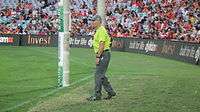
An umpire is an official in the sport of Australian rules football. Games are overseen by one to three field umpires, two to four boundary umpires, and two goal umpires.
Bandy
.jpg)
A game of bandy is officiated by a referee, the authority and enforcer of the rules, whose decisions are final. The referee may be assisted by one or two assistant referees.
Baseball and softball
In baseball and softball, there is commonly a head umpire (also known as a plate umpire) who is in charge of calling balls and strikes from behind the plate, who is assisted by one, two, three, or five field umpires who make calls on their specific bases (or with five umpires the bases and the outfield). On any question, the head umpire has the final call.
Basketball

In international basketball and in college basketball, the referee is the lead official in a game, and is assisted by either one or two umpires. In the National Basketball Association, the lead official is referred to by the term crew chief and the two other officials are referees. All of the officials in a basketball game are generally accepted to have the same authority as the lead official and therefore they are collectively known as the officials or referees.
Boxing
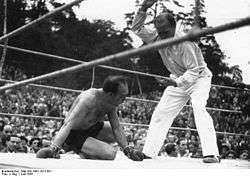
In boxing a referee is the person who enforces the rules during the fight. He gives instructions to the fighters, starts and stops the count when a competitor is down, and makes the determination to stop a fight when a competitor cannot continue without endangering his health.
Cricket
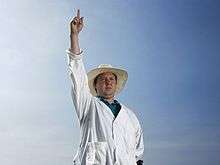
In cricket, the match referee is an off-field official who makes judgements concerning the reputable conduct of the game and hands out penalties for breaches of the ICC Cricket Code of Conduct. On-field decisions relevant to the play and outcome of the game itself are handled by two on-field umpires, although an off-field third umpire may help with certain decisions.
Cue sports
In cue sports, such as billiards and snooker, matches are presided over by a referee. The referee will determine all matters of fact relating to the rules, maintain fair playing conditions, call fouls, and take other action as required by these rules. (Source: World Pool-Billiard Association)
Cycling
A commissaire is an official in competitive cycling.
Fencing
A fencing match is presided over by a referee. The referee must award a point to the fencer with right of way during the final action in the event of a double touch in foil and saber. A typical bout has one head referee and a video referee and at the request of a fencer can also have two visual referees.
Field hockey
An umpire in field hockey is a person with the authority to make decisions on a hockey field in accordance with the laws of the game. Each match is controlled by two such umpires, where it is typical for umpires to aid one another and correct each other when necessary .
Figure skating
A referee in figure skating sits in the middle of the judges panel and manages and has full control over the entire event.The referee represents the International Skating Union at international events. Referees for international events are trained by the International Skating Union. There are two levels of referee, International Referee and ISU Referee, with ISU Referees ranking higher.
In Synchronized Ice Skating, there are two Referees. One, sits with the Judges as with ordinary competition and operates a touch screen computer, inputing deductions and marking the skaters. The other, known as the Assistant Referee — Ice, stands by the barrier where the teams enter the ice. The ARI monitors ice conditions, communicates with the event Referee and supervises teams.
Floorball
A floorball game is controlled by two referees with equal power.
Football (American and Canadian)
An American football (or Canadian football) referee is responsible for the general supervision of the game and has the final authority on all rulings. The referee is assisted by up to six other officials on the field. These officials are commonly referred to as "referees" but each has a title based on position and responsibilities during the game: referee, head linesman ("down judge" in the NFL), line judge, umpire, back judge, side judge, and field judge. In the modern XFL, an additional "ball judge", who wears a red hat, is on the field, but does not have the power to call penalties.
Football (association)
.jpg)
An association football (soccer) match is presided over by a referee, whom the Laws of the Game give "full authority to enforce the Laws of the Game in connection with the match to which he has been appointed" (Law 5). The referee is oftentimes assisted by two assistant referees, and sometimes by a fourth official. In UEFA football 2 additional assistant referees are used, each one standing next to a goal post and directly behind the goal line, to watch for fouls occurring within the penalty area and to see if the ball enters the goal.
Football (Gaelic)
.jpg)
There are usually 7 officials in Gaelic football. A main referee follows the play around the field and has the final authority on decisions such as fouls, throws and card-issuing, un-disputable by players. The main play referee is assisted by two linesmen, who make decisions on who gains possession when the ball goes out of the field of play, and can also advise the referee on off-the-ball events such as a fight or an illegal tackle. As well as the referee and two linesmen, there are two umpires at each end of the field of play who stand on either side of the goal post and raise a white flag for a point, or a green flag for a goal respectively, also calling wides and square-balls. An umpire can also advise the referee on off-the-ball incidents, but does not hold as much authority as a linesman. In recent times, technology called 'Hawk-eye' can be used if both the umpires and referee are unsure of whether a point has been scored or not, though this technology is not widely available.
Golf
Golf is often played without referees. According to the Middle Atlantic Section of the PGA of America, "few golfers are fully qualified to serve as referees." A golf referee must remain alert during matches and enforce the rules of golf.[1]
Handball
According to the International Handball Association, team handball games are officiated by two referees with equal authority who are in charge of each match. They are assisted by a timekeeper and a scorekeeper. (Source: International Handball Association, Rules of the Game, 1 August 2005).
Hurling

There are usually 7 officials in hurling. A main referee follows the play around the field and has the final authority on decisions such as fouls, throws and card-issuing, un-disputable by players. The main play referee is assisted by two linesmen, who make decisions on who gains possession when the ball goes out of the field of play, and can also advise the referee on off-the-ball events such as a fight or an illegal tackle. As well as the referee and two linesmen, there are two umpires at each end of the field of play who stand on either side of the goal post and raise a white flag for a point, or a green flag for a goal respectively, also calling wides. Any umpire can also advise the referee on off-the-ball incidents, but does not hold as much authority as a linesman. At inter-county senior games and other important matches, an eighth official, the "Sideline Official", receive substitution notes and holds up the number of substituted players and the amount of additional time, similar to a soccer fourth official.[2] In recent times, technology called Hawk-Eye can be used if both the umpires and referee are unsure of whether a point has been scored or not, although this technology is not widely available.
Ice hockey
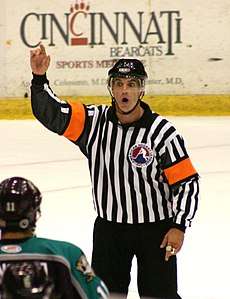
Games of ice hockey are presided over by on-ice referees, who are generally assisted by on-ice linesmen. The combination of referees and linesman varies from league to league. A few leagues, including the NCAA, are starting to refer to linesmen as assistant referees. In addition, off-ice officials administer to specific functions such as goal judge, penalty timekeeper, game timekeeper, statistician, official scorer and, at the highest professional levels, instant replay official.
Korfball
In korfball, it is the referee's responsibility to control the game and its environment, to enforce the rules and to take action against misbehaviour. He is assisted by an assistant referee, who alerts the referee to out balls and fouls and may have other tasks determined by the referee, and where possible by a timekeeper and scorer.
Lacrosse
A lacrosse match is presided over by a crew of either two, three, or in some cases four on-field officials. In two-man crew, a Referee and an Umpire are utilized. In a three-man crew, a Referee, Umpire, and Field Judge are utilized. The Referee shall always have the final ruling on any and all matters. For games of significance a four-man crew can be used which includes a three-man crew plus a Chief Bench Official who has jurisdiction over the bench area including the timekeeper. The professional outdoor league in the United States utilizes four on-field officials in order to be able to better keep up with the increased pace of play.
Lawn bowls
A lawn bowls match is presided over by a bowls umpire or technical official. In games where single players compete, a marker is required to direct play and assist players with questions relating to the position of their bowls.
Mixed martial arts
Rules in mixed martial arts (MMA) bouts are enforced by a referee who can give warnings and disqualifications should the rules be broken. The referee is also in charge of stopping fights when a fighter "cannot intelligently defend himself" in order to prevent him from incurring further damage, as well as making sure that submissions are released following a tapout and to pull fighters off an unconscious opponent. The referee is advised by a doctor and assistant referee who sit ringside.
The primary concern and job of an MMA referee is the safety of the fighters.
Motorsport
Aside the race control who are responsible for the start, running and timekeeping of the race, each section of the circuit is presided by a team of marshals led by an observer, who also report incidents and technical mishap of the race.
Netball
In the game of Netball the match at hand is Presided over by 2 umpires, typically female, with a comprehensive knowledge of the rules. There are also 2 timekeepers and 2 scorekeepers who inform the umpires, and players of time remaining, and scores.
Roller derby
The game of roller derby is governed by a team of up to seven skating referees. (Only three are required due to the grass-roots nature of the sport, though the full seven are used whenever possible). The required referees are a head referee, who oversees the running of the entire game and has final say in any disputes, and who doubles as an inside pack referee, following alongside the main pack of skaters from inside the track and issuing and enforcing penalties for fouls or infringements of the rules; and two jammer referees who follow the two point-scoring players known as jammers. Additional referees fill the roles of a second inside pack ref and up to three outside pack refs, who perform similar duties to the inside pack refs, but from the outside of the track, and who rotate active duty in a relay-race style to avoid fatigue caused by the extra speed needed to keep pace with the pack from the outside. Non-skating officials complete the team by recording and communicating points and penalties and ensuring skaters serve their time accordingly. Only the team captains may engage in discussions with the referees by way of the head referee, over calls made. Referees are also responsible for ensuring the skaters are correctly wearing all regulation safety equipment.[3]
Rowing
In a regatta an umpire is the on-the-water official appointed to enforce the rules of racing and to ensure safety. In some cases an umpire may be designated specifically as starter, or otherwise the umpire starts the race from a launch and follows it to its end, ensuring that crews follow their proper course. If no infringements occur, the result is decided by a judge or judges on the waterside who determine the finish order of the crews.
Rugby league
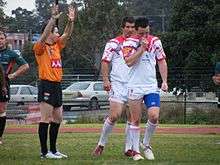
Rugby league games are controlled by an on field referee assisted by two touch judges, and often a video referee during televised games. With non-televised games in rugby league, the referee has 2 touch judges and 2 in-goal judges to assist. The referee and the touch judges cannot be contradicted by any player, but captains may discuss calls with them. In some rugby league competitions, most notably Australia's National Rugby League, public criticism of officials by players or coaching staff can result in fines being levied against the offending club.
The National Rugby League is also experimenting with a two-referee system: the control referee is primarily in charge of the play and calling penalties, and the assist referee, who communicates with the control referee but should not blow the whistle. The two referees exchange roles on changes of possession.
Touch football
Touch football/touch rugby (commonly known as "touch") has a unique refereeing concept. As in most team sports, there is an on-field referee and referees on each of the two sideline. However, in touch football, the referees may interchange, similar to players, at appropriate times. Appropriate times may include when the play has moved close enough to the sideline for the referees to swap without the interrupting the play. This may occur during a set of six or during a change of possession. Other times that referees may interchange include after the awarding of touchdowns and penalties.
Touch is also one of the few remaining sports where referees wear metal badges on their chests to represent their official level within their governing organisation. In Australia, the highest referee level is 6, the lowest being 1. In New Zealand, the highest level is 4, the lowest being 1. Prior to level 1, there is an elementary level beginners. In Europe, the highest level is 5, the lowest being 1.
Rugby union
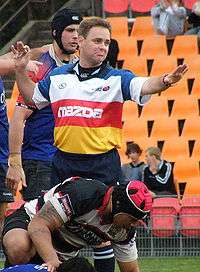
Rugby union games are controlled by an on field referee assisted by two Assistant Referees (AR's), and often a Television Match Official (TMO) during televised games. The referee and the touch judges cannot be contradicted by any player, but captains may discuss calls with them.
Sailing
Referee are rarely present during sailing races as decisions are normally referred to a jury-style protest committee after the race. However, sometimes in match race and in team racing an "umpire" is an on-the-water referee appointed to directly enforce the Racing Rules of Sailing. An umpire is also used in fleet racing to enforce Racing Rule 42 which limits the use of kinetics to drive the boat rather than the wind.
Shooting
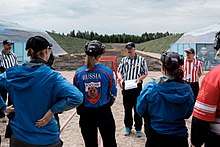
In practical shooting competitions within the IPSC, Range Officials acts as referees. The International Range Officers Association is the part of IPSC with the responsibility to train and certify range officials in order to ensure that matches are run safely, fair and according to the rules. The Range Officer (RO) is the lowest ranking referee, and the one issuing range commands and following the competitor during the Course of Fire. The Chief Range Officer (CRO) oversees the Range Officer, and has primary authority over the particular course. The overall authority for all officials in the entire match is held by the Range Master (RM).
If an athlete disagree with a call made by a Range Officer, he may consult the Chief Range Officer to challenge the call. If the call is still upheld, the matter may be brought to the Range Master. Finally, if the call is upheld by the Range Master, the athlete may lodge a formal protest to the Arbitration Committee. However, some referee calls may not be challenged by the athlete, particularly those regarding safe firearms handling.
Sumo
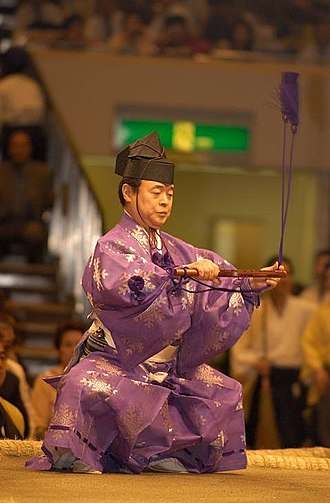
A sumo match is overseen by a referee (行司, gyōji) in the ring and five judges (勝負審判, shōbu shimpan) seated around the ring. All dress in traditional Japanese clothing, with higher-ranked referees wearing elaborate silk outfits. The referee oversees the pre-match rituals and the bout itself, including ruling on the winner of the bout and the winning technique used. If one of the umpires disagrees, then all the umpires confer to determine the winner of the bout.
Tradition holds that if one of the two top ranked gyōji has his decision overturned, he is expected to tender his resignation, although the Chairman of the Japan Sumo Association usually rejects the resignation.
Tennis

In tennis an umpire is an on-court official, while a referee is an off-court official.
Underwater hockey
An Octopush or underwater hockey match is presided over by two or three water referees in the pool, a chief referee on deck, and at least one timekeeper and one scorekeeper. Additional timekeepers can be used to track penalty times in highly contested matches. A tournament referee will arbitrate for chief referees, whilst protests will be adjudicated by at least three independent referees.
Volleyball
A volleyball match is presided over by a first referee, who observes action from a stand, providing a clear view of action above the net and looking down into the court. The second referee, who assists the first referee, is at floor level on the opposite side of the net—and in front of the scorers' table. They are often referred to informally as the "up referee" and "down referee," respectively. While the first referee watches over actions involving the ball (and thus the attacking team), the second referee usually judges errors committed by the defending team, like touching the net.
Wrestling (amateur)
The international styles of amateur wrestling use a three-official system in which a referee conducts the action in the center of the mat while a judge and a mat chairman remain seated and evaluate the action from their stationary vantage points.
Collegiate wrestling uses a single referee in the center of the mat, or a head referee and an assistant.
Wrestling (professional)
In professional wrestling, the referee's on-stage purpose is similar to that of referees in combat sports such as boxing or mixed martial arts. However, in reality referees are participants in executing a match in accordance with its pre-determined outcome as well as any other events that are scripted to take place during the match. They also function as a conduit for communication between the wrestlers and backstage officials during matches.
Other uses
Military
In a military exercise or field training exercise, the umpire (or observer) is a non-participating officer tasked with monitoring personnel in the field. The umpire does not give orders to the soldiers being observed, nor does the umpire provide any information as to unreleased details of the exercise. Their role is strictly to observe and provide reviews of actions taken, especially where military personnel performed in an innovative way or showed selfless effort.
Role-playing games
A gamemaster acts as an organizer, officiant for regarding rules, arbitrator, and moderator for a multiplayer role-playing game.[4][5] They are more common in co-operative games in which players work together than in competitive games in which players oppose each other.
Attire
Referees typically wear clothing to distinguish themselves from the players. Such uniforms may be distinctive, and some traditional uniforms have come to be symbolically associated with the position (even if newer, alternative uniforms are increasingly used). Notable examples include the traditional black uniform worn by association football referees, or the vertical black and white stripes worn by referees in many North American sports.[6][7] These two traditional uniforms have led to the informal terms "the man in black"[8][9] and "zebra,"[10][11] respectively.[12] It is also not uncommon for referees to wear bright reflective shirts.[13]
See also
References
- "How to Referee" (PDF). PGA of America, Middle Atlantic Section. Retrieved 19 February 2016.
- https://www.gaa.ie/my-gaa/match-officials/sideline-officials
- "The Rules of Flat Track Roller Derby - Women's Flat Track Derby Association". Wftda.com. Retrieved 2016-07-18.
- Rosenberg, Aaron; Dupuis, Ann; Houle, Melissa (2005). The Deryni NextAdventure Game. Grey Ghost Press, Inc. p. 106. ISBN 978-1-887154-09-3.
- Porter, Greg (June 1988). SpaceTime. Richmond, VA 23233: Blacksburg Tactical Research Center. p. 1. ISBN 0-943891-03-5.CS1 maint: location (link)
- "Football: The Men in the Striped Shirts". Time. Letters. 3 January 1969. Retrieved 7 January 2015.
- Kennedy, Pagan (1 November 2013). "Who Made That Referee Shirt?". The New York Times. Retrieved 7 January 2015.
When Olds first wore the black-and-white-striped shirt in 1921, he “received plenty of boos from the crowd,” he told an interviewer.
- Hyde, Marina (26 March 2014). "Andre Marriner debacle highlights Fifa aversion to video technology". The Guardian. Retrieved 2 July 2014.
- O'Hagan, Simon (28 January 1996). "Rosy future for man in black". The Independent. Retrieved 2 July 2014.
- Gruley, Bryan (24 October 2014). "Better Referees: Why College Football Needs to Herd Its Own Zebras". Bloomberg. Retrieved 18 April 2015.
- Lukas, Paul (10 March 2004). "Uni Watch: How the zebra got its stripes". Slate.com. Retrieved 18 April 2015.
- Andy Griffith, in his routine "What It Was, Was Football," derisively and laughably referred to them as "convicts" for that reason.
- Alex Yannis (1 March 1994). "Soccer: The Name Game". The New York Times. Retrieved 8 January 2015.
Another first for World Cup '94 will be a change in the color of the officials' uniforms from basic black to lighter colors
External links
